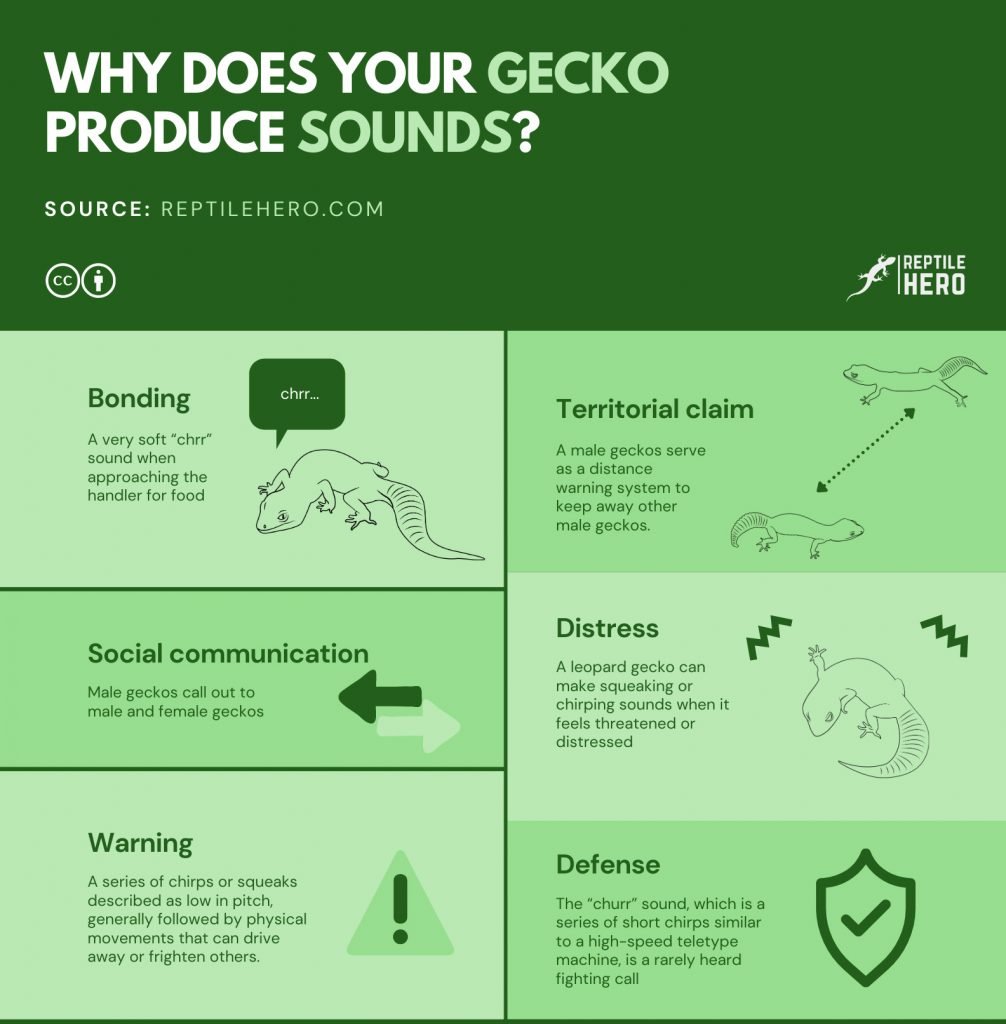6 Reasons Why Geckos Make a Clicking Sound [With Science]
For thousands of years, different cultures believed that when you hear a gecko calling, it’s the sound of fate, of luck, or of visitors coming. However, scientific research tells us more about gecko sounds.
Leopard geckos often emit chirping or clicking sounds, which are typically indicative of stress. When you observe such noises, it is crucial to prioritize your gecko’s well-being. Provide your gecko with an opportunity to rest and create a safe environment that is devoid of potential stressors. By eliminating any factors that may cause distress, you can help ensure the overall health and happiness of your pet leopard gecko.
In the days before electricity was widely used, gecko voices were often heard at dusk. When the day transitions into night, it’s a time of mystery, gas lamps, torches, bonfires, and stories for comfort and entertainment. This is where gecko superstitions were shared.
Why Does Your Gecko Produce Sounds?

Geckos vocalize more in late spring when their androgen levels and gonad sizes increase. Another reason is that their first call is a series of pulses while their second call is a set of two-note series of syllables.
- In addition, red geckos from Laos, Vietnam, and Thailand produce a third set of single notes, with no silent intervals.
- However, black geckos from northeast Vietnam and China are silent between pulses in their first call, and between syllables in their second call.
Geckos produce sounds, often clicking, in several social interactions such as bonding and territorial claim. The sounds that a gecko can produce can also be different in terms of the number of repetitions, sound duration, tone, and frequency.
Let’s see each reason in detail
Bonding
When approaching food geckos can produce a soft sound, resembling a clicking but not quite like This is also difficult to hear so more often than not that’s not the reason for an audible clicking sound.
Territorial Claim
A 2020 paper on the male Asian house gecko (H. frenatus) concludes that several sets of chirps sends messages of territory, sex, or even indicating body size.
- Territorial boundary calls are also indicated in a 1962 report from the Scientific Papers of the Namib Desert Research Station.
- Male geckos also produced a sound during territorial struggles, according to researchers S. Nobuo and H. W. Campbell in their 1967 report.
- A 1977 report from the Smithsonian Institution says that the calls of male geckos serve as a distance warning system to keep away other male geckos.
Social Communication
A 2012 report from Japan on the generally silent house gecko (Gekko japonicus) describes that geckos use their voice:
- Male geckos call out to male and female geckos. However, females almost always call out only to male geckos.
- Male geckos only call out to geckos that they’ve had physical contact. After the first physical contact, they tend to communicate more frequently.
A 2019 report adds that geckos call out to advertise their identity and condition. This type of call is different from distress calls.
Distress
A 1976 report from the keeper of reptiles and amphibians at the National Zoological Park of the Smithsonian Institution in Washington, D. C., describes gecko sounds such as a cry of distress when handled.
- A leopard gecko can make squeaking or chirping sounds when it feels threatened or distressed.
- Similarly, a 2013 paper about a new gecko species that the researchers found in an Australian rainforest describes an extended sound similar to squeaking.
- A 1977 study states that geckos give out single chirps to warn about predators. However, when communicating with other geckos, they chirp.
Warning
In a 2012 report, V. S. Briggs describes the vocal exchanges between male and juvenile geckos (Hemidactylus turcicus). The elder geckos produced warning sounds, a series of chirps or squeaks described as low in pitch, generally followed by physical movements that can drive away or frighten others.
Defense
In a 1992 report, M. F. Bates describes a gecko’s defensive strategies against predators, including the production of shrill squeaks, rapidly sharp clicking sounds, as well as a low, extended “rurr” or guttural sound, or even a screaming sound.
The “churr” sound, which is a series of short chirps similar to a high-speed teletype machine, is a rarely heard fighting call when there is an aggressive encounter between two male geckos, according to a 1974 report by D. Marcellini.
Juvenile geckos can make grinding or screaming sounds to scare away any source of threat. When caught, a gecko can produce a soft, squeaking sound, says a 1946 report from the biology department of Birla College.
When Does Your Gecko Produce Those Sounds Naturally?
Excluding situations of distress (due to handling for instance) your little four paws friends produce some vocalization when 1) mating 2) copulating and 3) navigating.
Mating
A 1985 report from China describes the gecko’s August mating call as a series of about 8 to 9 or 12 to 13 times “geck-ko, geck-ko” per set.
- This generally happens from evening till midnight or dawn, but this type of gecko calls are silent in the daytime.
- A 2003 report from the University of Puerto Rico reveals that only males make multiple chirps, and mainly during courtship only.
- A 1989 study describes four types of gecko sounds: several rattles for distress, a long and complex sequence of grumbling sounds for territorial or mating, and a short, soft call to-ko sound related to sexual activity.
A 2006 report from the Trinidad and Tobago Field Naturalists Club describes gecko sounds from a reluctant or unwilling female gecko during courtship, and after copulation.
Males geckos made a rasping hiss (like a “shrr” sound) after separation or while chasing after females.
Navigation
A 1998 report published by Oxford University Press describes how sound is transformed into nerve impulses.
- D. Marcellini’s 1977 study confirms that geckos have great vision and poor hearing. In addition, they are better able to interpret sounds for navigation in dim or low-light conditions.
- A 1976 report on the gecko’s vocalization for communication from McGill University in Canada describes how geckos use sounds and echoes for orientation.
- Nocturnal animals with restricted vision such as geckos are highly dependent on accurate sound localization to identify their prey, says a 1972 report by S. D. Erulkar of the University of Pennsylvania Medical School.
- A 2012 study published in the Journal of Comparative Neurology indicates that gecko brains can differentiate information from various types of sounds that they hear.
- Due to the unique design of their ears, eardrums, and their large, open-mouth cavities, the ears of geckos can accurately determine the direction of sound sources, according to a 2011 paper.
- A 2010 report by C. Bergevin of Columbia University in New York states that smaller geckos can hear high-frequency sounds better than bigger geckos. At the same time, geckos with fewer hair cells or shorter papilla in their inner ears are better at fine-tuning low-level tones.
- Gecko ears are so sensitive that they can hear crickets, even those that are in burrows that protect them from geckos, says a 1984 report from the University of Toronto.
What the Superstitions Say

Reptiles (such as turtles, crocodiles and alligators, snakes, lizards and goannas) are silent except for geckos, legless lizards, and skinks. Although geckos are usually quiet, they have vocal cords that can create a variety of sounds.
In many cultures, the sounds of geckos are linked with positive beliefs such as good fortune, prosperity, and great luck or are considered bad omens in others. Here are some examples:
- Hawaii: Old-timers in Hawaii and in some Polynesian islands will tell you that gecko calling means good luck and that killing one brings bad luck.
- Philippines: Legend tells that at dusk, at exactly 6:00 p.m., geckos descend to kiss the ground and call out to ask for forgiveness. Their voice is considered a sign of good luck or money that’s coming.
- Polynesia: In the islands of Polynesia, old societies used to revere the calling gecko as deities, often represented in ceremonies as monstrous lizards.
- Sri Lanka: Rural Sri Lankans have many beliefs about the gecko’s cry. Here are some examples:
- Don’t leave the house if a gecko cries out; it’s calling out a warning.
- When a family makes a decision, a gecko’s soft chirp means “Go ahead” but a loud cry means the decision should be changed.
- If you hear a cry from behind, someone who envies you will try and cause you trouble.
- A gecko’s cry from your left means good fortune is coming your way; if it cries out from your right, that’s a sign of bad luck about to happen.
- Thailand: Old folks say that a gecko in the house is a grandparent who has been reborn to protect you. They call out to tell you something. For example:
- Don’t leave home if you hear a gecko; something bad may happen to you.
- A gecko calling out between 6 a.m. and noon means good news is coming to someone who lives in the house.
- A gecko calling out between 12:01 p.m. and 6:00 p.m. is a sign of something bad to come.
- A gecko sound heard between 6:01 p.m. and midnight indicates both bad and good news coming.
- However, a gecko sound heard between 12:01 a.m. and 6:00 a.m. means nothing.
- If you hear the sound of a gecko four times in a row, the family will face trouble within 15 days.
- However, if you hear a gecko cry out seven or more times, you’re about to have some good luck.
- USA: In the deserts of Arizona, American Indians believe that gecko sounds are a message of good luck. Some Native American communities believe that geckos cry out when something is about to harm a child.
What Does Science Say?
There are at least 1,196 kinds of geckos and they make different sounds. Different cultures name geckos by the sound they make such as gec-ko (English), to-kay (Indonesian), ge-koq (Malaysia), or chee-chak (Singapore, Malay).
The most familiar sound of geckos in all continents (except Antarctica, where you’ll never find one) is a series of loud calls at dusk that sound like “Tok-ko! Tok-ko! Tok-ko!”.
Male geckos cry out but females are quiet but emit a hissing sound when threatened. The whistle of the African whistling gecko is so loud that it’s deafening.
Researchers describe gecko sounds in different ways. In other words, descriptions of gecko calls are nonstandard.
- Some reports compare gecko calls to barking dogs, and some to ducks.
- Some say the gecko sound is high-pitched clicking, chirping, hissing, or like the creaky sound of a rusty hinge.
- Others describe the gecko call as creaks like a cork being pulled out of a bottle, a sharp “chirp!” or a soft “pip, pip, pip: similar to the sound of a small bird.
- The sound of baby geckos is described as soft screaming, like a kettle coming to a boil.
- A 2017 source from Pakistan describes gecko sounds as singing and also as a chorus.
Aside from the piercing, two-syllable calls that give the gecko its name, there are many things we don’t know about the sounds of geckos.
For instance, geckos emit sounds not only from their throats or upper respiratory tracts, but also from their ears and tails. A 1973 report says that gecko sounds are made by expelling air, modulating sound, or rubbing body parts. Geckos can also produce sounds that we can’t hear at all.
Sounds From Gecko Throats
Geckos are generally quiet pets. That’s why, when one vocalizes, pet owners pay attention… or even worry. When they open their mouths wide, that’s not for screaming but for making sounds louder. Research tells us more.
- Like birds and mammals, geckos are the only species of lizards that have vocal cords for calling out and making different sounds.
- The gecko’s vocal cords create chirping sounds that are used for social interaction.
- According to a 2001 report on how androgens control sound and hearing processes, the tokay gecko (Gekko gecko L.) can produce loud, complex vocalizations.
- This is echoed in a 2019 research paper describing how geckos vocalize loudly. The only other reptile that can do this is the crocodile skink.
- Geckos use a pair of vocal cords in their larynx to make sounds, says a 2016 report on sound production by researchers from the University of the Pacific.
- Calls or most often used by male geckos to mark their territory as well as during courtship.
- Young geckos and females used vocal sounds in the process of providing maternal care to their offspring, as well as to synchronize hatching.
- When they feel threatened, adults, as well as juvenile geckos, produce hissing sounds.
- The gecko’s call is composed of three parts with a regular sequence, says a 2016 paper on evolutionary ecology. The paper also says that:
- At least eight species of male geckos use calls during courtship.
- Four of these species use regular patterns that only females of their species only can identify and issue a response.
- In the species without regular patterns in their calls, the responding female geckos come from any species.
Sounds From Gecko Ears
Geckos emit sounds from their ears to help them navigate, similar to how submarines use sonar echolocation to know if something blocks their way. Here’s what the research explains.
- The inner ears of geckos automatically produce acoustic energy as well as emit sounds called spontaneous otoacoustic emissions (SOAE).
- These sounds can be measured by sensitive microphones placed in the canal of the external ear.
- SOAEs help geckos hear better because of the activity of their hair cells (papillae), says a 2008 report published in the Biophysical Journal.
- In 2010, C. Bergevin found that geckos with shorter or fewer papilla (hair cells in the ears) have broader tuning abilities and smaller geckos hear higher-frequency sounds.
- Changes in the size of the mouth (oral cavity), as well as changes in air temperature, affect the quality of sounds produced by their ears, says a 2018 report.
- Drugs can affect the stability of sound patterns in the gecko’s ears. According to a 1999 report from Rockefeller University, gecko ears with strong functions were weakened while ears with weak functions were strengthened.
Sounds From Gecko Tails
Like their cousin lizards, geckos are known to escape predators by detaching their tails, which continue to wriggle while they make their escape. What’s surprising to know is that their tails can also emit sound.
- Researchers found that male geckos vibrate their tail-ends rapidly to produce sounds.
- For instance, the wonder gecko or frog-eyed gecko can produce a rasping or buzzing sound by rubbing together the scales on its tail in waves.
- To mislead their predators, some the frog-eyed gecko (T. scincus) can mimic the buzzing sound produced by the saw-scaled viper (Echis carinatus), says a 2015 research paper from Iran.
- A 1993 report describes this as a warning sound produced by dorsal scales on the gecko’s tail.
Conclusions
Now that you know more about gecko sounds, here’s a short list of takeaways to remember.
- Superstitions: The sound of geckos is interpreted in complex superstitions from different cultures around the world. For instance, when, where, and how geckos call are interpreted as either good or bad omens.
- How they do it: The sounds that geckos make can come from hair in their ears, vocal cords in their throats, or scales on their tails.
- Why they do it: Gecko sounds differ according to species and purpose such as bonding, courtship, and mating; defining territory, warning, or self-protection.



![Why Does Your Gecko Lick? [You, Themselves, and Other Objects]](https://www.reptilehero.com/wp-content/uploads/2021/05/gecko-lick-object-cc-768x614.jpg)


![10 Reasons Why Your Gecko Is Sneezing [With Solutions]](https://www.reptilehero.com/wp-content/uploads/2021/03/Why-gecko-sneeze-cc-768x614.jpg)
